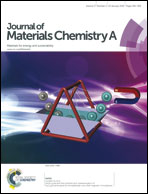Construction of Cu@ZnO nanobrushes based on Cu nanowires and their high-performance selective degradation of polycyclic aromatic hydrocarbons†
Abstract
Highly active Cu@ZnO brush-like nanostructures have been successfully synthesized through the heteroepitaxial growth process of ZnO branched nanorods (NRs) based on Cu core nanowires (NWs), and used for the evaluation of selective catalytic degradation for polycyclic aromatic compounds. The resultant Cu@ZnO nanobrushes, with the main diameter of ∼500 nm, consist of Cu core NWs with diameter of ∼50 nm and outer ZnO branch NRs shells with thickness of ∼250 nm. The as-designed Cu@ZnO nanobrushes exhibit high performance for the selective catalytic degradation of polycyclic aromatic compounds. Nearly 90% conversion with the reaction rate constant (k) of 0.012 min−1 can be achieved for anthracene, while only about 50% and 10% conversions are shown for phenanthrene and naphthalene, respectively. Besides the highly efficient transportation of electrons, Cu NWs have strong capacity for oxygen activation which results in the gathering of negative charges and rich chemisorbed oxygen onto the surface, which is responsible for the high catalytic efficiency of Cu@ZnO nanobrushes toward the selective degradation of anthracene.


 Please wait while we load your content...
Please wait while we load your content...